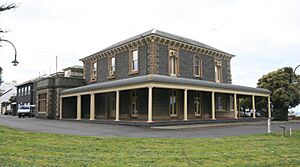Osborne House (Geelong) facts for kids
Osborne House is a very old building in North Geelong, Victoria, Australia. It was built in 1858. This grand house has a long and interesting history. It has been used for many different things over the years.
Contents
The Story of Osborne House
Early Days and First Owners
Osborne House was built in 1858. It was made for a man named Robert Muirhead. He was a squatter, which means he settled on land that he didn't officially own yet. Robert Muirhead named his new home after Osborne House, which was Queen Victoria's summer house in England.
Famous architects from Melbourne, Webb and Taylor, designed the house. Robert Muirhead lived there until he passed away in 1862. After his wife also passed away, the house was sold. For some years, it was rented out. Then, in 1878, it was sold to James Francis Maguire.
In 1900, the Victorian Government bought Osborne House. They planned for it to be a country home for the Governor of Victoria. However, it was never actually used for this purpose.
A few years later, in 1905, the Geelong Harbour Trust bought the house. They paid 6000 pounds for it. In 1910, they added a dining room and seven bedrooms. The Trust used Osborne House as a guest house for several years.
In 1911, the Geelong Harbour Trust offered the house to the Royal Australian Navy. At first, the Navy didn't accept the offer. But in 1913, they decided to use Osborne House as a college to train naval officers.
Many improvements were made to the buildings. New buildings were put up for unmarried sailors to live in. Two new classrooms were added. The main room was changed into a large sleeping area for 28 cadets.
The college officially opened on March 1, 1913. The Governor General, Lord Thomas Denman, opened it. The Prime Minister, Andrew Fisher, was also there. Lord Denman arrived by a special boat called a torpedo boat. About 200 guests came by train from Melbourne.
The college had 28 cadets, four petty officers, and 10 seamen. There were also instructors and staff. The first group of 28 cadets was chosen from 137 people who wanted to join. Osborne House was thought to be a good permanent spot for the college. This was because it was close to train transport and had a safe place for ships in Corio Bay. However, the naval college moved to HMAS Creswell at Jervis Bay in 1915.
Later Uses and Changes
During World War I, Osborne House became a military hospital. From 1919 to 1924, it was used by the Royal Australian Navy Submarine Service. They used it as a base for their six J-class submarines.
The Geelong Harbour Trust got the house back in 1929. Only a caretaker lived there then. In 1937, the Shire of Corio bought the property. They used it as their main offices. In 1939, the Department of Defence took over the building. They used it as an army training centre.
In 1945, the Shire of Corio got Osborne House back for their offices. They bought more land next to it in 1947. The offices were updated in 1966. In 1995, the shire joined with the City of Greater Geelong. After this, Osborne House was empty for a while.
Osborne House Today
Today, the old stables at Osborne House are no longer used for horses. They now house the Geelong Maritime Museum. The Geelong Memorial Brass Band also uses part of the stables. The main house itself is used by various community groups.


